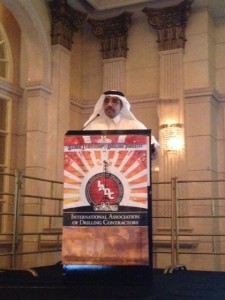Industry growth, influx in young work force present opportunity to build safety culture, competencies
By Joanne Liou, editorial coordinator

The Middle East accounts for almost 40% of the world’s proven oil reserves, and with that comes both responsibility and opportunity to safely provide continuous and reliable energy resources, said Khaled Al Buraik, VP of drilling & workover, Saudi Aramco. A burgeoning pool of talent and multifaceted safety initiatives are helping the region to overcome challenges associated with the high level of activity and industry growth. “Human resources is an enabler, and they are the ones that enable us a safe workplace and also an environmentally responsible work force,” Mr Al Buraik said at the 2012 IADC Critical Issues Middle East Conference in Dubai on 4 December.
Reflecting on activity growth in the Middle East, Mr Al Buraik noted that the region has experienced a 10% increase in rig count since 2011, and that upward trend is forecasted to continue. “This translates to approximately 11,000 new workers, not to mention replacing attrition and the retiring work force,” he said.
Although the big crew change presents an industrywide challenge, Mr Al Buraik highlighted an opportunity to enhance the safety culture and competent work force with an influx of newcomers, particularly in the Arabian Gulf nations. “In the next few years, it is estimated that 60% of the regional work force will be under the age of 30. We have the opportunity to create a new culture with untainted, ambitious, talented personnel overall through knowledge transfer and training programs,” he said. “Through quality competency training and continuous training evaluations and commitment from management, we will be able to bridge the knowledge gap and provide those talented individuals with the possibility to flourish.”
The expansion of the industry, geographically and technically in new areas of exploration and development, is triggering new risks. High energy demand and the development of unconventionals have added new areas to the drilling map while the complexities of today’s drilling operations have birthed new technologies and associated risks, Mr Al Buraik explained. “With technological advances and breakthroughs comes exposure to new risks, risks that must be recognized and managed,” he added, which again highlights the importance of having a capable and knowledgeable work force.
Among Saudi Aramco’s initiatives to help meet the demands for a competent work force, the company is working with IADC to update well control training guidelines. The aim is to improve the preventive measures that are taught during training, in addition to training on other well control issues.
Saudi Aramco also has implemented a three-year field deployment program to streamline hands-on training of young and talented engineers, the majority selected from the local work force, Mr Al Buraik said. The company is in the process of developing a drilling academy that will provide five test wells with manual and automatic rigs to provide training and competency development for operator personnel, technicians, roughnecks and drillers.
To monitor the drilling department’s compliance with Saudi Aramco safety standards and policies, the company has established an operational excellence and compliance rule. “This multifaceted approach has enabled Saudi Aramco to expand its operations in a safe manner without jeopardizing its people and environment,” Mr Al Buraik stated.
Saudi Aramco’s efforts and similar ones implemented by other companies in the region have produced positive results, he believes. The Gulf Cooperation Council (GCC), which includes the UAE, Bahrain, Saudi Arabia, Oman, Qatar and Kuwait, recently noted some of the region’s successes. “It is evident that the Middle East lost-time incidence (LTI) frequency is the second-lowest in the world. Furthermore, according to the latest GCC technical executive meeting, even with the rapid expansion, the GCC countries have the lowest LTI frequency in the Middle East and North Africa regions.”




